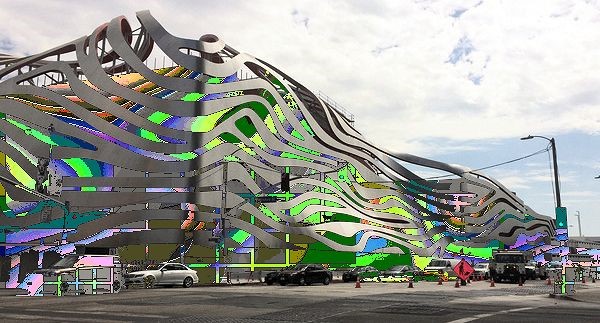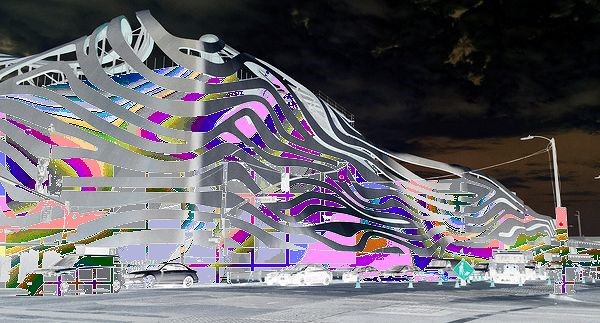2015.12.18 19:08
18 December
2015.09.30 10:25
The Icon is that kind of sign that is most like its object--"a sign which stands for its object because as a thing perceived it excites an idea naturally allied to the idea that object would excite." Most icons are indeed likenesses. ... An Index, by contrast, holds no resemblance to its object, it simply points to it: "An index stands for its object by virtue of a real connection with it, or because it forces the mind to attend to that object."
--Vidler/Pierce
The object of the Petersen Automotive Museum "ribbons" is to "evoke a sense of speed and movement." Ribbons do not move on their own, yet they are perfect indices of air movement, especially of air moving at high speed.
It seems KPF took a sophisticated indexical approach to "evoke a sense of speed and movement" rather than a simplistic iconic approach to "evoke a sense of speed and movement" by being a likeness to an aero-dynamically designed auto body (which would actually more evoke a sense of friction reduction so the building can then move faster[!?]).
2015.10.01 15:24
Rather than falling within the category of parametricism, the Petersen Automotive Museum is an updated example of building/facade as sign, introducing a new type of index, even.



further acceleration 2015.09.29:
Architecture Critic Mark Lamster: "We systemically encourage bad building."
Quondam: Don't just embrace the junk, make it junkier!
That's exactly accelerationism!


So again 2015.12.18:
Don't just embrace the junk, make it junkier!
That's exactly accelerationism!

| |
2015.12.27 14:14
bilbao effect: various definitions
from:
Terence Riley, MoMA
Complex Geometries: Plotting a Course presented 30 April [1999] at the "Digital Translations" symposium University of Pennsylvania Graduate School of Fine Arts
"I think architects are feeling the possibility of being slightly old fashioned. And it is a real question now, is architecture a still art, or is it one of the old fashioned fine arts? Or, through the media, can it be part of this new kind of performing art. And I think Bilbao is key to understanding this. So, to understand this idea of competition and where it might be leading us, we have to recognized the changed relationship between architecture and the media, and how that effects the perception of architecture by the public. We just had this symposium at MoMA, John Rajchman was moderator, and it was a very interesting session where a number of the leading architects in the world started talking about the "Bilbao effect". I had no idea of how much these architects were not thinking about the building but were thinking about what the building had done to change architectural culture. And Peter Eisenman, who is not very confessional most of the time, I found to be incredibly confessional, admitting that he doesn't know the difference between a theme park and good architecture these days. There is a very fine line between the two, and he finds that his ability to distinguish the two is changing, and he illustrated this by telling the story of being on a jury in Frankfurt where he and one other architect and, in his words, fourteen bureaucrats. There were five architectural projects, he felt that the one was the most radical, and somehow he had to convince the jury that this was "the" radical project. How would he defend it against these bureaucrats? They had a vote, and it was 16-0 in favor of the radical project. All the bureaucrats were saying, "this will be like Bilbao; it will be great; all the tourists will come." Eisenman had a real shock. What he was realizing, of course, was that, well, I'll come back to it later. Frank Gehry himself tells a very similar (in terms of import) story. He was very proud that when EuroDisney was being built, he resisted being given a theme building. He insisted that Bob Stern can do "New York, New York", but "I don't do a theme building." So he was very proud that Disney agree that he could do this space that was about (I don't remember what it was called), but it was a fun place to go, and it was a Frank Gehry building. He said that once he went to see it though, he had a kind of revelation, and he realized that Disney had won, because in that environment, they had gotten him to do a theme building. He did a Frank Gehry theme building. He had become a theme in [Euro]Disney. And it goes on and on, and some these stories . . ."
published at Quondam 1999.07.07
also:
Bilbao "Affect" 001
2000.08.09
Ichnographia Quondam.
project: The Working Title Museum
site: east bank of the Schuylkill River, Quondam




| |
2015.12.27 17:37
was Hillary mocking Shubow? the new world order not Greek?
The Stack (or at least the part I've read) is all about the new digital dimension of geopolitics. Clinton's quotation begins the 'A New Architecture?' section of Bratton's "Introduction." He writes, "Looking to contemporary design for new models of geopolitical architecture [like global information systems], both literal structures and figurative systems, may be a good idea (regardless of whether Gehry's singular and floral morphologies are necessarily the best option), but what drives this demand for new armatures and diagrams of global power and sovereignty?"
Rodham-Clinton's use of a private email account for all her emails while Secretary of State instead of using a governmental email account for governmental email is perhaps a more apt corollary (lesson) for Bratton's The Stack: On Software and Sovereignty.
2016.01.21 10:33
Scott Merrill wins the 2016 Driehaus Prize

I've now decided to execute this design in imitation of the Classical style. After all, it's only natural for the cluster and meander of sculptural nudes to be complemented thusly.
|